In recent years, the travel app industry has experienced remarkable growth, signaling a vibrant market ripe with opportunities for businesses and investors alike. If you’re thinking about investing in travel app development, there’s no better time than now to dive in.
In this blog post, we’ll walk you through essential insights, including:
- Popular travel app concepts;
- An exploration of various business models;
- A step-by-step guide to the travel app development process;
- A dive into cost considerations and more.
By the end of this article, you’ll have a clear understanding of the types of travel apps that can deliver the most value to your business. You’ll also identify actionable strategies to bring your app idea to life and maximize profitability.
Ready to embark on this journey? Let’s get started.
What is a travel app?
A mobile travel app is a handy tool you can access on your smartphone or tablet, designed to simplify trip planning, booking, and management.
Travel apps can do a variety of things, from searching and booking flights, hotels, or rental cars to offering travel guides, maps, and itineraries. Many also include extras like currency converters, language translators, and local tips to enhance your experience.
In short, an app for travel puts everything one needs for a journey right at their fingertips, making travel simpler and more enjoyable.
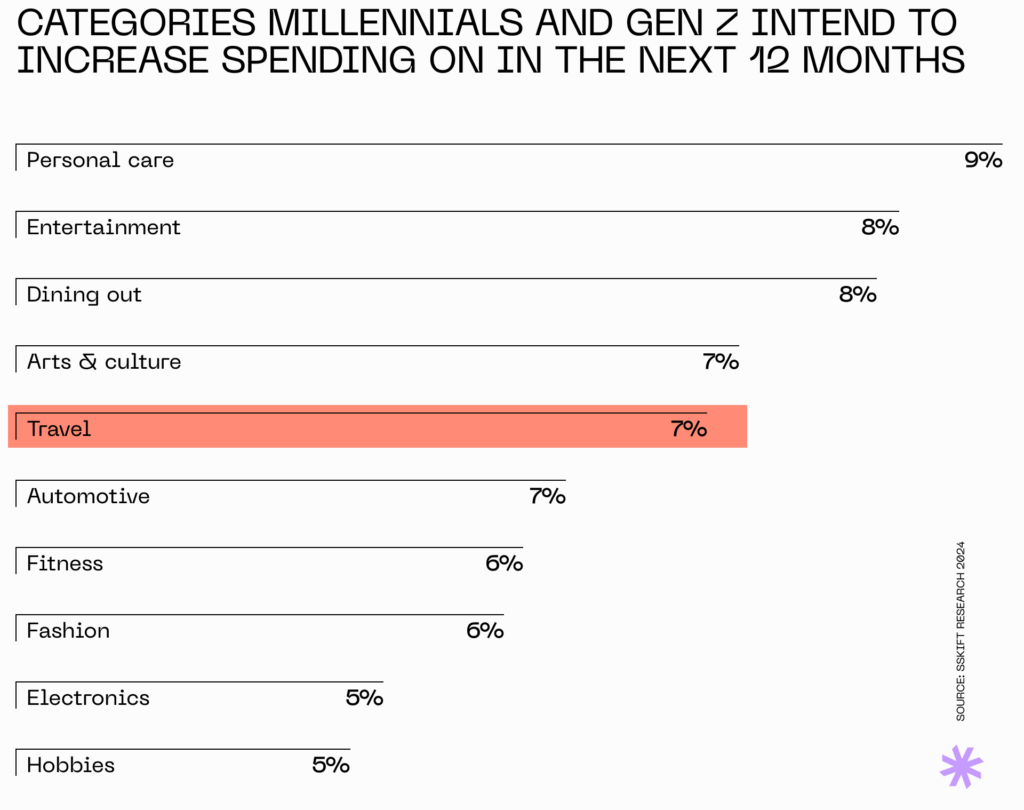
How do travel apps work?
The main goal of a travel app is to simplify every aspect of trip planning, booking, and management.
You begin by searching for what you need—whether it’s flights, hotels, or activities. The app gathers data from various sources to present you with options and prices. Once you’ve made your choice, you can book directly through the app, which securely handles payments.
Many travel applications also organize all your travel details in one place, including your itinerary, maps, and confirmation numbers. Plus, some even offer real-time updates, like flight changes, to keep you informed on the go.
How to create a successful travel app in 8 steps?
Travel app development is actually just one phase within the broader process of creating a travel application. Before coding a mobile solution, it is essential to thoroughly conceptualize your idea and confirm its alignment with market demands.
1. Conduct competitor research
By examining your competitors, you can gain an understanding of what’s already available and what users expect from a travel app. This insight helps you spot the strengths and weaknesses in existing solutions, enabling you to identify market gaps and create a travel app that truly stands out.
Start your competitor research by identifying companies that offer similar products or services or cater to the same user needs. Then, assess the popularity of their software, how customers perceive its value, and how easy it is to use. Try to evaluate the application from different user group perspectives, for example, travel agents and regular customers.
Stop when you’ve figured out what works well and what to avoid and have some ideas on how to build a travel app that offers something uniquely valuable to users.
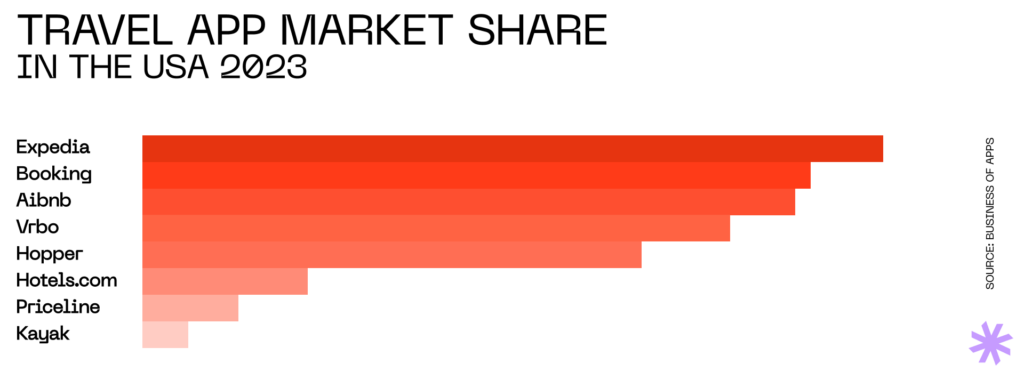
2. Decide on the travel app features
Based on the target users’ needs and preferences you uncovered during competitor research, identify the key features that are absolutely essential to meet those needs. For instance, frequent travelers might prioritize booking options, while occasional tourists might find local guides more valuable.
In travel app development, there are several ways to prioritize features. One of the most well-known methods is SWOT analysis, which Syndicode’s experts often use to help clients who rely on our business analysis services to identify the most crucial features for their solutions.
Be cautious not to overload your app with too many features, as this can overwhelm users and lead to wasted resources on functionality that’s rarely used. Plus, the more features you include, the more expensive travel application development will be.
Additionally, consider where your target audience is most active and choose your platforms accordingly.
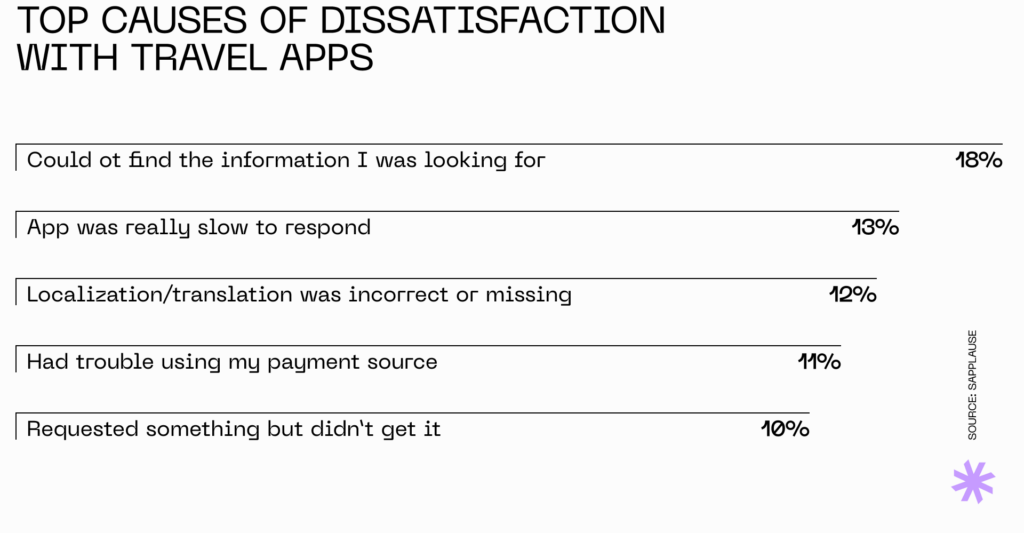
3. Find a travel app development team
The right development team is the one that has the skills and experience to bring your vision to life within your budget and timeline.
When hiring, you have a few options:
- Freelancers: Ideal for smaller, budget-friendly projects, but they might lack the resources for complex apps and can be tough to manage on larger projects.
- In-house team: This option gives you full control over travel application development and close collaboration, but it’s more expensive and takes time to set up.
- Outsourcing: Travel app development companies provide dedicated teams with diverse expertise. They can manage everything from design to launch, making them ideal for larger projects. Additionally, hiring a dedicated development team offers benefits like cost savings while maintaining quality, although you may face challenges with communication and time zones.
To evaluate the capabilities of a specialist or an agency, you can follow these steps:
- Review their portfolio: Look for similar projects they’ve successfully completed to ensure they understand your needs.
- Check client references or reviews: See how well they deliver on promises, especially regarding deadlines and budgets.
- Interview them: Discuss your project in detail and ask how they would approach it. This helps you assess their understanding and problem-solving skills. You could also assign a small test task to evaluate their work quality.
- Set up a clear contract. Include milestones and deadlines to keep the project on track. Remember to sign an NDA to protect your intellectual rights.
4. Enter the discovery phase
Also known as a discovery session, this is the first phase of the actual travel app development process. It lays the groundwork for a successful app, ensuring it resonates with users and meets market demands.
During this phase, your development team works closely with you to understand your vision and goals, helping to avoid costly mistakes later on.
The team dives into learning about your target audience, their needs, and your business competitors. They collaborate with you to outline the app’s key features, design, and user experience, making sure everything aligns with what users want. This phase might also involve gathering feedback from potential users and studying successful travel guide apps to ensure the app is well-suited to real market conditions.
By the end of the discovery process, you’ll have a clear, documented outline of the features to be developed and a structured plan for the software development process tailored to your budget and timeline. You’ll also have a solid understanding of what makes your app unique, allowing you to kick off early marketing efforts.
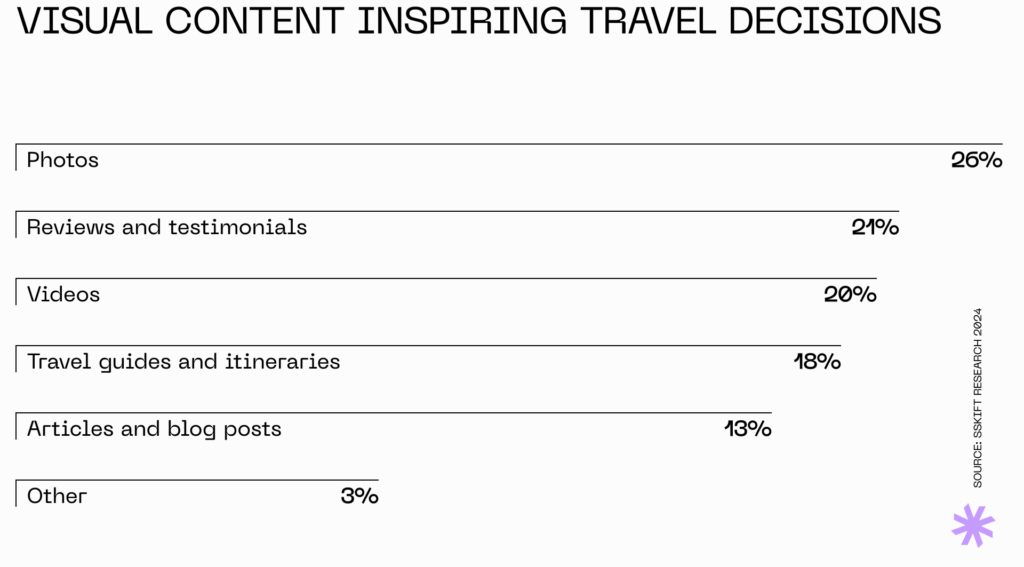
Get the business analysis done for you
Describe your travel app idea, and our experts will return with an analysis and recommendations per current and projected market conditions.
Write us5. Build the travel app
At this stage, the actual coding and development of the travel app take place. Developers build the app’s features based on the design and requirements defined earlier. This includes integrating both the backend (like databases and servers) and frontend (the user interface) components, along with thorough testing to ensure everything runs smoothly.
The development stage is critical because it’s where any overlooked details or planning issues can surface, potentially impacting the project budget, shifting deadlines, or causing technical problems that slow down progress. In addition, bugs and other unexpected issues often arise due to human factors in coding and may require extra time to fix.
Whether you’re creating a web app or a mobile solution, to mitigate risks, we often recommend starting with a Minimum Viable Product (MVP). An MVP is a basic version of your app that includes just the core features needed to satisfy early users. The benefits of building an MVP include:
- Faster launch: You can get your app to market more quickly.
- Cost efficiency: It reduces costs of travel application development by focusing on the essentials.
- User feedback: You can gather real user feedback early on, which helps you improve the app.
- Reduced risk: By starting small, you minimize the risk of investing too much in features that might not be necessary.
Once you’ve launched the MVP of your travel app and confirmed that your concept has gained traction, you can continue developing the mobile application and gradually adding more features.
6. Test and launch
Even a small issue can trigger a chain of events with major aftereffects and damage to your travel app’s reputation. Incidents like the Knight Capital mishap highlight the critical importance of thorough software testing.
Fortunately, in most cases, a standard testing flow can prevent and eliminate issues that could significantly impact your app, ensuring it’s reliable, enjoyable to use, and ready to impress users from day one. The typical software testing lifecycle includes:
- Unit testing: Checking individual parts of the app for errors.
- Integration testing: Ensuring different components work well together.
- Usability testing: Getting real users to use the app and provide feedback on its design and functionality.
- Performance testing: Making sure the app runs efficiently under various conditions, such as heavy user traffic.
These steps help ensure your travel app is ready to shine.
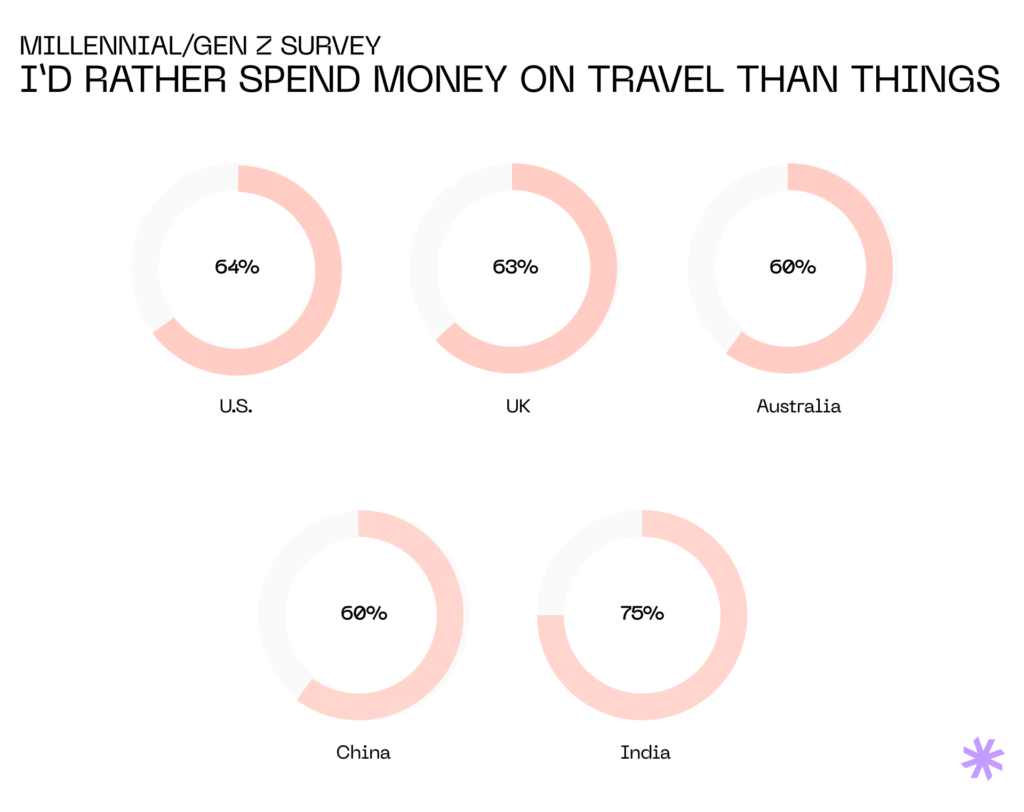
7. Market your travel app
No matter how great your app is, people need to know about it to use it. Effective marketing helps you reach your target audience, build excitement, and drive downloads, which is essential for your app’s success.
To build momentum and create a ready audience eager to download your app when it launches, it’s smart to start marketing early, even before travel application development begins. Here’s a basic marketing plan you can follow on a tight budget:
Before travel app development:
- Create a landing page: Outline your app’s concept, key features, and benefits. This helps you start building a subscriber list that will become your app’s loyal user base.
- Establish a social media presence: Share updates about the development process, engage with potential users and begin building a community.
During travel app development:
- Content marketing: Publish blog posts, travel tips, or videos related to your app’s features. This drives traffic to your website and keeps potential users engaged.
- Partnerships and collaborations: Connect with travel influencers, bloggers, or other brands. As you approach the launch, they can help promote your app to a wider audience.
- Beta testing: Offer early access to a select group of users. This provides valuable feedback and creates word-of-mouth buzz.
Before launching:
- Announce the launch: Send an email to your subscriber list and post across all your social media channels. Create excitement with engaging content like countdowns, videos, or special promotions.
- Leverage influencers and partners: To boost your reach, make sure any influencers or partners you’ve worked with promote your app on launch day.
- Celebrate and encourage downloads: Offer launch day promotions, such as discounts, exclusive content, or giveaways, to incentivize downloads and shares.
After launch:
- Collect and act on feedback: Quickly address any bugs or issues and consider adding requested features in future updates.
- Ongoing marketing: To attract new users, keep up with content marketing, social media engagement, and email campaigns. Consider running targeted ads or promotions to reach a broader audience.
- Regular updates: Continuously improve your app with new features, bug fixes, and updates based on user feedback and your travel app development roadmap.
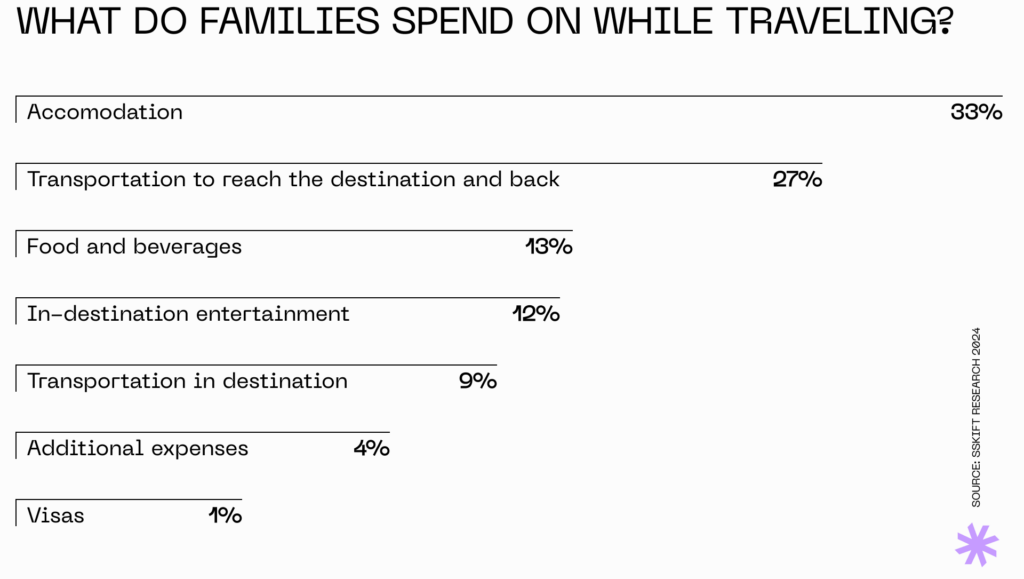
8. Support and improve
As your app ages, it might start to slow down or become outdated with changes in security or technology, which can affect user satisfaction and data integrity. To keep your app relevant and competitive, you need to make sure it’s regularly updated and checked for bugs.
Here’s how to keep your app in top shape:
- Regular updates: Continuously improve your app by fixing bugs, boosting performance, and adding new features based on user feedback.
- User support: Offer a reliable way for users to get help, whether through in-app support, chat, or email.
- Monitor performance: Use analytics to track your app’s performance. Address any issues that arise, like crashes or slow loading times, to ensure a smooth user experience.
Bring your idea to life
At Syndicode, you’ll find expert guidance, innovative solutions, and a team that delivers on time and within budget. Contact us today to discuss your project and take the first step toward creating a successful travel app!
Contact usTop types of travel apps
Travel is a broad and diverse experience that involves many different needs at various stages. This makes it tough for a single app to handle everything without becoming too complex or expensive.
The table below categorizes travel apps by their main purposes and features. Understanding these categories will help you make informed decisions about your travel application development, ensuring it’s well-positioned in the market.
| App type | Purpose | Main features | Examples |
|---|---|---|---|
| Travel planning & itinerary management | Help users organize and manage their travel plans and itineraries. | Trip organization, Itinerary creation, Calendar integration, Document storage, Collaboration | TripIt, Google Trips, Roadtrippers |
| Booking apps | Allow users to book travel services like flights, hotels, and cars. | Search and compare options, Secure booking and payment, Real-time availability, Price alerts | Expedia, Kayak, Skyscanner |
| Accommodation apps | Help users find and book places to stay during their travels. | Hotel and rental search, Booking and payment, Reviews and ratings, Filters (price, location, etc.) | Airbnb, Booking.com, Hotels.com |
| Transportation & navigation apps | Assist users in navigating and accessing transportation options. | Maps and GPS navigation, Public transit info, Ride-hailing services, Offline maps | Google Maps, Uber, Citymapper |
| Experience & cultural apps | Provide users with local experiences, tours, and cultural insights. | Local tour booking, Cultural guides and tips, Event information, Language support | Viator, Culture Trip, GetYourGuide |
| Price monitoring apps | Track and notify users of price changes for flights, hotels, and other services. | Price alerts, Price history tracking, Notifications, Deal alerts | Hopper, Skyscanner, Google Flights |
| Travel reviews & recommendation apps | Offer user-generated reviews and recommendations for travel services and locations. | User reviews and ratings, Recommendations, Photos and videos, Search by category | TripAdvisor, Yelp, Foursquare |
| Specialty travel apps | Cater to specific travel niches or needs (e.g., adventure travel, pet-friendly). | Niche-specific search and booking, Custom itineraries, Specialized content | AllTrails, Roadtrippers, BringFido |
Key points to consider when creating a travel app
Target audience groups
Different people use travel apps for different reasons. Figuring out who will use your application helps you identify their pain points and tailor the app to make it more valuable and appealing.
Here are the main types of users for travel apps:
- Frequent travelers usually travel for business and seek convenience and efficiency. Apps targeted for them typically include features like booking, itinerary management, and real-time updates.
- Leisure travelers are tourists looking for help with vacation planning, local experiences, accommodations, and cultural insights.
- Budget travelers are users focused on finding deals, tracking prices, and getting the most value for their money.
- Adventure travelers seek outdoor activities, niche experiences, and specialized content like hiking trails or extreme sports.
- Family travelers need family-friendly options, such as child-friendly accommodations, activities, and safety tips.
- Solo travelers might look for safety features, social connections, or local guides designed for independent adventures.
Must-have features of a travel app
Even if you don’t start with building an MVP, it’s still a good idea to prioritize and keep the features in your travel app development minimal. This ensures you include all the essential functionality while avoiding features that aren’t frequently used.
Here’s a list of features commonly found in the most popular travel apps in the USA as of this writing.
| Feature | Description |
|---|---|
| User accounts and profiles | Allows users to create and manage their own accounts, where they can save their preferences and view booking histories |
| Search and discovery | Enables users to find specific services or information |
| Booking and reservations | Allows users to book services directly through the app, usually with secure payment options |
| Location-based services | Uses GPS and location data to provide information about nearby attractions or services |
| Maps and navigation | Includes maps and navigation tools to help users find their way, explore new areas, or track routes, often with real-time updates |
| Reviews and ratings | Features user-generated reviews and ratings to help users evaluate the quality and reliability of services based on other people’s feedback |
| Offline functionality | Lets users access certain app features without an internet connection |
| Photos and media | Shows visual content to help users make informed decisions |
| Notifications and alerts | Sends push notifications or alerts for important updates |
| Filters and sorting | Enables users to narrow down search results based on criteria like price, location, rating, or availability |
Make your mark in the travel industry
Syndicode has the skills and resources to create a powerful, feature-rich app for your business entirely from scratch. Get in touch with us now!
Let’s talkAdditional features to consider for a competitive advantage
While core features ensure your travel app meets travelers’ basic needs, extra features are what make it stand out in a crowded market.
The tricky part is that these unique features are what set your app apart, so there’s no one-size-fits-all guide to tell you exactly what they should be. To discover the perfect standout feature for your tourism app development project, you’ll need to collaborate with experienced business analysts and have a deep understanding of what resonates with your target audience.
In this section, we’ll highlight some unique features offered by today’s most popular travel planning apps. Hopefully, these examples will inspire some ideas for your own travel app development project.
| App | Unique feature | Description |
|---|---|---|
| Airbnb | Unique experience booking | Ability to book unique local experiences and activities curated by hosts, not just accommodations. |
| Expedia | Multi-service bundling | Allows bundling of flights, hotels, and car rentals into a single package for discounts. |
| Google Earth | 3D virtual tours | Provides detailed 3D maps and virtual tours of landmarks, exploring any location from a satellite view. |
| Vrbo | Whole-home rentals | Focuses on renting entire homes or vacation properties, not just rooms or shared spaces. |
| Booking.com | Wide assortment of filters | Enables users to narrow their search to a specific appliance, such as a socket near the bed or a tennis table. |
| PeakFinder | Mountain identification | Uses augmented reality to identify mountain peaks in real time, providing names and elevations. |
| LiveATC | Real-time air traffic control streaming | Allows listening to live air traffic control communications from around the world. |
| Old World Search | Historical place search | Specializes in locating and exploring historical sites and landmarks globally. |
| OruxMaps | Advanced GPS tracking | Offers customizable GPS tracking for outdoor activities, supporting multiple map formats and offline use. |
| US Public Lands | Public land boundaries | Provides detailed maps showing public land boundaries in the U.S., aiding in finding federal lands for recreation. |
| Uber | Ride-share integration | Integrates different ride types (UberX, UberPool) and includes Uber Eats for food delivery within the same app. |
| Lyft | Round-up & donate feature | Allows rounding up fares to the nearest dollar and donating the difference to charity. |
Tech stack for travel app development
Choosing the right tech stack is crucial for making sure your travel app is efficient, scalable, and cost-effective.
Below are the key points to consider when deciding on a tech stack for your travel application development. For more detailed tips on how to choose the best tech stack for your project, check out our earlier blog post.
- Performance and scalability: Before selecting your tech stack, it’s a good idea to create a small prototype and run benchmark tests. This will help you see how it handles a large number of users, high transaction rates, and complex operations. Some tech stacks may struggle with heavy loads or scaling, which could affect user experience.
- Maintenance and support: Technologies can quickly become outdated. Choosing a less popular or niche tech stack might make it harder to find developers or get community support later on. To gauge whether a tech stack will remain relevant, check industry reports and look into the community around it.
- Compatibility: Not all tech stacks work well across different platforms (iOS, Android, web). Make sure the technologies you choose are compatible with the platforms you’re targeting. Otherwise, you might face limitations or need extra resources to manage multiple codebases.
- Future-proofing: Choose a tech stack that aligns with your long-term goals. If you plan to add complex features in the future, selecting the right stack now can save you time and costs.
| Category | Technology | Description |
|---|---|---|
| Front-end technologies | React Native | Used by Airbnb for cross-platform development, reducing the need for separate iOS and Android codebases. Ideal for teams with JavaScript and React experience. |
| Flutter | Google’s UI toolkit for building natively compiled mobile, web, and desktop applications from a single codebase. Best for a polished and smooth UI experience. | |
| Swift, Objective-C, Java, Kotlin | Ideal for native travel mobile app development, offering platform-specific advantages on Apple devices (Swift, Objective-C) and Android (Java, Kotlin). | |
| Back-end technologies | Node.js | A JavaScript runtime built on Chrome’s V8 engine, suitable for building scalable and fast back-end apps, particularly for real-time applications. |
| Ruby on Rails | A web application framework using Ruby, prioritizing developer productivity and easy maintainability of apps. | |
| Python | A high-level programming language known for its simplicity and readability, widely used for web development, data science, automation, and more. | |
| Database technologies | MongoDB | A NoSQL database for handling unstructured or semi-structured data. |
| MySQL | A relational database management system widely used for structured data, transactions, and data integrity. | |
| Cloud services | Amazon Web Services (AWS) | Provides a variety of cloud computing services, including server hosting, storage, and databases, with extensive global data center coverage. |
| Google Cloud Platform (GCP) | Offers cloud-based services and infrastructure, ideal for projects requiring Google’s machine learning, data analytics capabilities, and ecosystem integration. | |
| Mapping and location services | Google Maps API | Offers robust mapping and location-based services for apps. |
| Mapbox | Provides customizable maps, navigation, and location search SDKs, best for apps requiring unique, branded maps. |
Request a detailed quote
Ready to bring your travel app vision to life? Share your project ideas with us, and we’ll provide accurate cost and timeline estimates to get you started.
Contact usTrends shaping the travel app industry this year
Investment in digital transformation continues to grow across the travel industry. Technologies like biometrics are already enhancing the travel experience, and the rise of Generative AI is set to accelerate changes even more.
Here are the top four trends in the travel industry impacting travel app development:
Personalization and AI: Travelers are seeking highly personalized, engaging experiences. This is particularly true in the luxury sector, where 85% rely on travel advisers for tailored trips, according to a Skift report.
The same report shows that while only a small percentage use AI tools like ChatGPT for travel planning right now, those who do are very satisfied. This suggests a growing potential for AI to provide personalized recommendations and support.
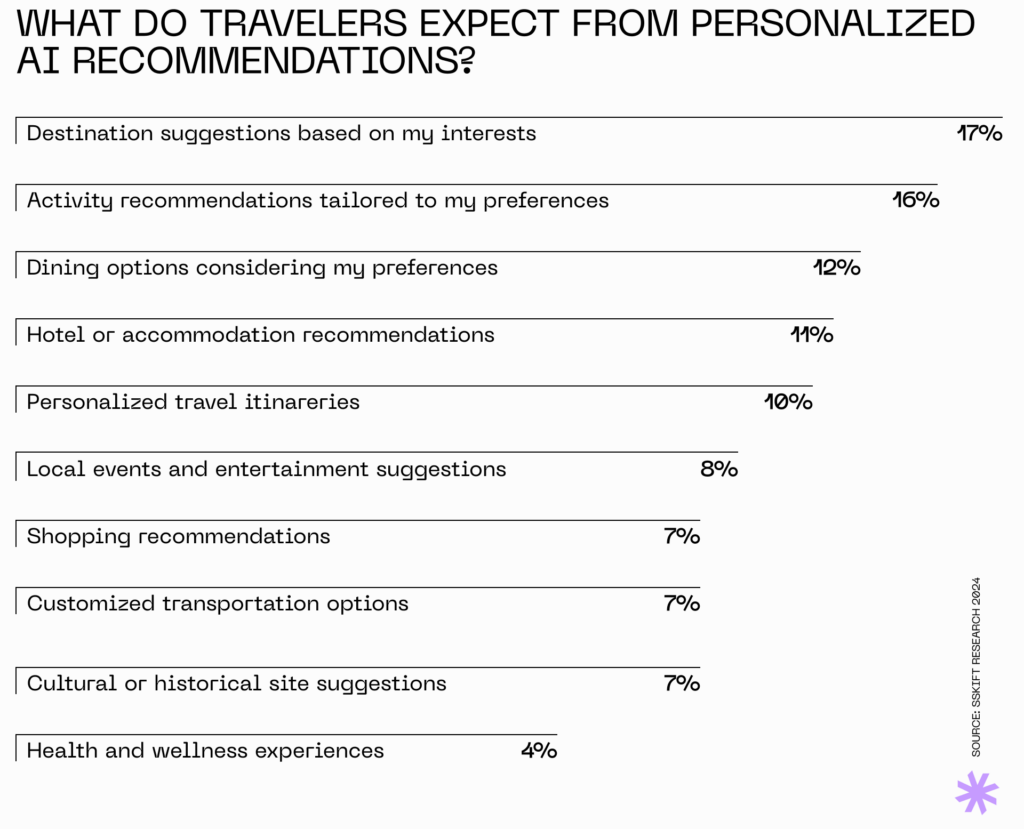
Sustainability: Travelers are increasingly prioritizing sustainability and prefer eco-friendly travel options. They’re willing to pay more for environmentally responsible services, even if it means less convenience.
Regenerative tourism is a hot topic, but with limited awareness, it’s unclear if it’s a solid investment. If you choose to invest, be prepared to educate your customers about it.
AR and VR: Travelers are favoring experiences over material goods. Augmented Reality (AR) and Virtual Reality (VR) can offer exciting new experiences, like virtual tours of hotels, attractions, and restaurants, or even entire cities. As AR technology becomes more accessible through smartphones and other devices, it can enhance travel apps by providing interactive and personalized experiences.
Social integration: Social media platforms are becoming key tools for travel research and booking. Features like direct booking on platforms such as Instagram show a trend towards convenience and trust in digital travel solutions.
Integrated platforms play a crucial role in modern travel behavior by reaching billions of users and streamlining the booking process.
How do travel apps make money?
The travel app industry brought in approximately $629 billion in revenue in 2023, according to the Business of Apps, and this number is expected to keep growing.
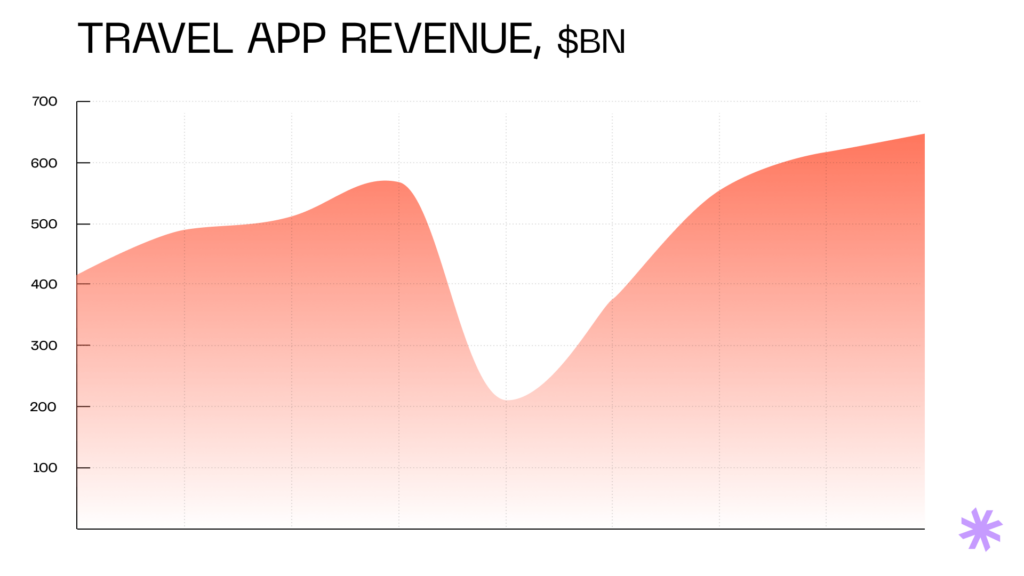
In such a competitive market, understanding how travel apps generate income is essential for developers and travel businesses. Here are four common monetization strategies for travel apps:
Advertising
This strategy involves displaying ads within the app, such as banner ads, sponsored content, or video ads. Revenue comes from impressions, clicks, or user engagement. Ads might promote related services like hotels, car rentals, or travel insurance. This works well for apps with a large user base, offering free access while earning through ad placements.
Commission
With this model, the travel app earns a percentage of transactions made through it. For instance, it might receive a commission on bookings for flights, hotels, tours, or car rentals. This is common in apps like Expedia and Booking.com, where revenue aligns with successful travel bookings.
Premium
The premium model offers a basic version of the app for free while charging for advanced features or exclusive content. Users can pay a one-time fee or subscribe to access premium features like offline maps, personalized itineraries, or an ad-free experience. This model appeals to users who want enhanced functionality while the app still attracts a broad audience through its free tier.
In-app purchases
This model lets users buy additional content, features, or services directly within the app. Examples include purchasing travel guides, local experiences, or detailed maps. It provides a flexible revenue stream by offering users the option to enhance their travel experience with specific add-ons, keeping the core app accessible to all.
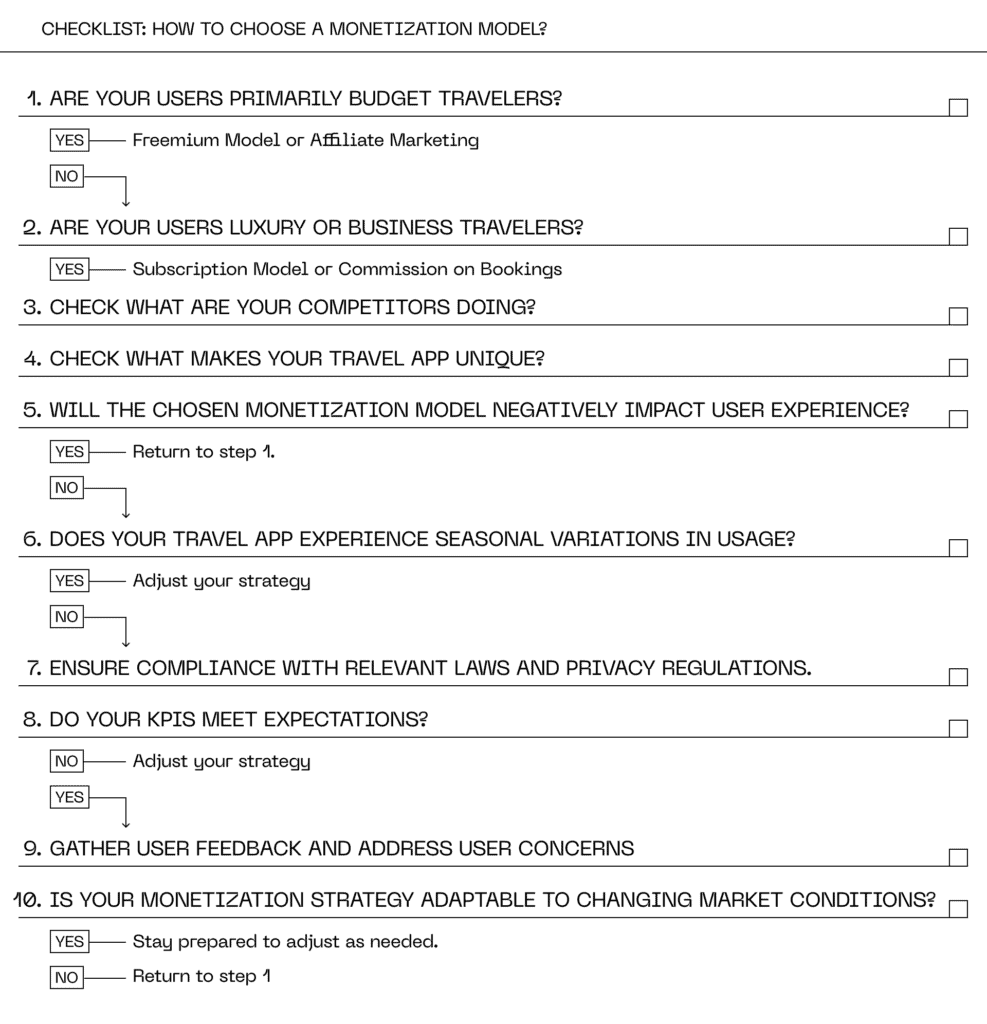
Cost of travel mobile app development
We have an extensive guide answering the question, how much does it cost to build a mobile app? In short, the price can vary significantly based on several factors. Here are the key elements that influence the cost of travel app development:
Geographical location
The location of your travel application development team or agency can significantly affect costs due to varying labor rates around the world. For example, in the USA, the average base salary for a software engineer is about $105K per year, according to Indeed.
As Payscale shows, the average salary for software developers in France is roughly $49K per year. Eastern Europe offers even more cost-effective options, with IT engineers earning an average of around $40K annually.
When choosing travel app developers, it’s crucial to consider not just the cost but also their expertise and experience with similar projects. Request quotes from several travel application development companies across different regions and carefully evaluate their capabilities to ensure they can effectively meet your project needs.
Platform (iOS, Android, Web)
Developing for multiple platforms can increase costs. Thus, building separate native apps for iOS and Android is typically more expensive than creating a cross-platform app. Adding a web version can further drive up costs due to additional development and testing needs.
App complexity
The cost is influenced by the number and complexity of features, functionalities, and integrations. More complex travel app development projects with advanced features require more time and resources. Integrations with external services like payment gateways or mapping APIs can add to both development time and licensing fees.
Project timeline
A shorter timeline can sometimes lead to higher costs due to overtime pay and an increased likelihood of errors, which may require additional revisions. Setting a reasonable timeline helps manage travel app development costs more effectively and ensures better quality.
App design and user experience
Complex designs, animations, and interactions require more design and development effort, which increases costs. When creating UX design for travel apps, it’s important to find a healthy balance between cost and appeal.
Data security and compliance
Handling sensitive user data necessitates strong security measures and compliance with data protection regulations like GDPR or CCPA. These requirements can add to development costs but are crucial for protecting user data and maintaining trust.
Marketing and promotion
While not part of the travel app development process, marketing, and promotion are essential for your app’s success. Budgeting for these activities ensures your app reaches its target audience and achieves its objectives.
To determine the exact cost of travel app development, define your project’s specific requirements and conduct a detailed scope analysis. For an initial estimate, consider using our custom software development project cost estimation guide.
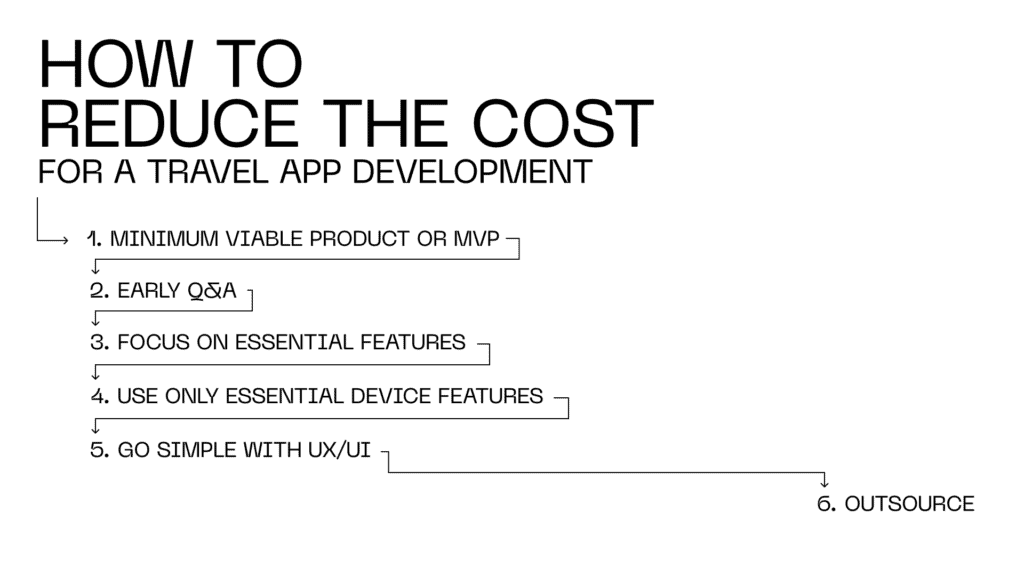
Closing words: how Syndicode can help make a travel application
Developing a successful travel application involves choosing the right tech stack and monetization model while focusing on security, personalization, and user experience. Staying ahead of industry trends like sustainability, AR/VR, and social connectivity is also key to standing out.
Whether you want to revolutionize travel or create a niche app, Syndicode offers comprehensive development services to bring your vision to life.
We’ve turned many innovative ideas into reality. For instance, we collaborated with HarvestInn, an Australian startup, to build a platform for motorhome travelers to explore unique destinations. We also worked with BookYaBike, an Austrian company, to create a centralized marketplace for bicycle rentals in Mallorca, simplifying the booking process for cyclists.
Contact us today to discuss your project and create a standout travel app.
Frequently Asked Questions
-
How to make a good travel app?
A good travel app should help users travel comfortably. It must offer intuitive navigation, real-time updates on flights and accommodations, robust search filters, offline functionality, and secure payment options. It should provide comprehensive destination information, including maps, local tips, and reviews. Personalization features like tailored recommendations and itinerary planning enhance the experience of app users. Additionally, excellent customer support and frequent updates for bug fixes and new features are essential for top-notch travel application development solutions.
-
How long does it take to develop a travel app?
Depending on complexity, travel app development typically takes several months to a year or more. It depends on several factors, including the desired features, platform (iOS, Android, both), team size, and development speed. You must define the app’s specific functionalities, design requirements, and integrations to receive a preliminary estimate. Once these details are clear, travel app development services can provide an approximate time frame, which varies based on unforeseen challenges and changes during development. At Syndicode, we minimize the deviations by conducting thorough risk assessments. In our quote, you will see time and cost estimates for best and worst-case scenarios so you can adjust your plans accordingly.
-
How can you monetize a travel app?
You can make money from a travel mobile application in several ways. One option is through advertising, where you show ads from travel-related companies and earn money based on how many people see or click on them. Another approach is commission-based revenue, where you get a cut from bookings made through the app, like for flights, hotels, or rentals. A premium model lets users access basic features for free but charges for advanced features, exclusive content, or an ad-free experience. In-app purchases are another option, allowing users to buy extra services or content, like travel guides or special deals, directly within the app. You can mix and match these methods to fit your app’s audience and goals.
-
How do I choose the right development tools for building a travel app?
When choosing travel app development tools, start by identifying the app’s key features and whether it will be available on iOS, Android, or both. If you’re creating native apps, Swift is the go-to for iOS, and Kotlin is ideal for Android. For cross-platform travel apps development, React Native or Flutter are strong options. Make sure the tools you pick can handle your app’s growth, such as using Node.js for a scalable backend. It’s also important to consider your team’s familiarity with the tools, as this will affect how quickly and efficiently the app can be developed. Lastly, focus on tools that easily integrate with essential features like mapping and payment APIs. If you struggle, our software development company can help by providing travel application consulting and development services.
-
How can I implement AI and machine learning in a travel app?
You can incorporate AI and machine learning into a travel app to create a more customized, efficient, and engaging experience, which can lead to higher user satisfaction and retention. For example, these technologies can suggest destinations, accommodations, or activities based on what users like and their previous choices. AI can also improve customer support by using chatbots to provide quick, automated help. Other popular applications of machine learning in traveling apps are to optimize pricing, predict travel trends, and refine search results by learning from how users interact with the app.
